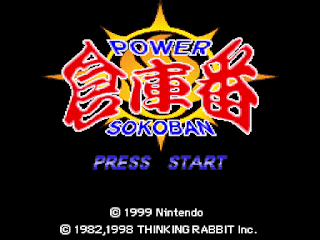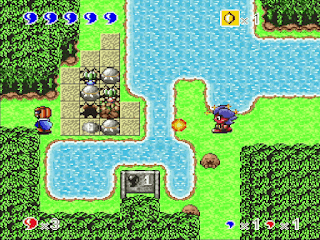Power Soukoban is an action puzzle game for the Super NES. The gameplay consists mainly of solving block puzzles while fighting off monsters.
One day, holes opened up in the ground all over Japan, and monsters from the West appeared from them and wreaked havoc throughout the land. As an oni child, you must seal the holes by pushing rocks into them, banishing the monsters for good.
~ from Romhacking.net
The Super Nintendo may have been discontinued in Europe and the US by 1998, but it was still chuggin along in its native Japan. In late June 1999 Nintendo published a little-known puzzler based on a well-known concept - block pushing. Developed by the long-running developer Thinking Rabbit and mixing in dashes of Zelda with a theme based on the Japanese demons called Yokai, that game was Power Sokoban.
Often called Boxxle, BoxyBoy or simply Shove It over here, Sokoban has quite the history in Japan. Directly translated as "warehouseman" in English, it began in 1982 on a Japanese home computer called the NEC PC-88 before travelling the world on DOS and Commodore systems in time for the decade's end. It has quite the history, so why have I singled out this one game on the Super Nintendo? Well, other than my inability to control the passing of time, it's entirely down to the unique and polished way Power Sokoban presents each of its single-screen block-pushing puzzles. In many ways, it reminds me of Zelda's 16-bit adventure A Link to the Past as you control a demon exploring the land and eventually saving it by blocking monsters rising from hell.
The map screen. This is where you can also save your game at any time (left).
Find these cat ladies if you ever need to replenish your health (right).
Find these cat ladies if you ever need to replenish your health (right).
To stop them from rising, you have to push boulder into the pits from which they rise. Until they're blocked, the spawn holes constantly spew up a variety of enemies. From fast-moving bats to stronger pumpkin-headed creatures, they do more to hinder puzzle-solving than they do by attacking you. The further you get into the game, the faster and more plentiful they will be, but they will also be more hardy taking more hits from your own attacks. You can defeat them by rolling a boulder over them, but your main offensive capability is the spitting of fireballs.
From the very beginning, the little demon you control has two basic forms of attack. Tap the 'A' button (or whatever button it's mapped to) and you'll shoot out a little projectile in front of you. Hold it down and he'll inhale for a brief moment before spitting out a large fireball. Keep holding and control will switch from the demon to the fireball itself allowing you to manoeuvre it as if it were a remotely controlled drone. This attack is more than just a means to do greater damage to enemies; it can also destroy breakable walls and even push a boulder by a single tile. This makes for some interesting puzzle solving, but compared to traditional Sokoban-style puzzles, it also lessens the difficulty somewhat.
Your power fireball can be controlled remotely to solve puzzles (left).
Permanent power ups like these water-walking boots tantalise you before you can reach them (right).
Permanent power ups like these water-walking boots tantalise you before you can reach them (right).
Once you've completed a puzzle, you'll be rewarded with one of three types of items; a red tear, a blue tear or a location specific item. If you collect 10 red tears, your attack power will increase by 1 meaning enemies will die in less hits. Collect 10 blue tears and your health will increase by 1 meaning you can take more hits. Those location specific items such as a hammer, sword or crucifix are used in the end of level bosses which play much more like an action game than a puzzle one. In these fights, up until they run out, your fireball is replaced with that item which deals far more damage than a standard attack. It can take four or five hits to down a boss in this way, but an agonising amount when using the standard attack. While not exactly difficult, these bosses often act in a way that isn't suitable to the little demon's moveset. They are faster than the slow moving projectiles which have a brief delay as the throwing (or spitting) animation plays out. That's fine enough for the methodical puzzle sections, but against a sprightly wolf or erratic vampire they feel inadequate. That being said, it's not impossible. Just expect to waste a lot of if not all of those powerful items before you get a hit in.
As you travel from a dungeon to a mountain top, a lush forest to the halls of a mansion, you'll find areas and items you cannot possibly access. This is because you have to find the ability to reach it. These include boots to walk on water or winged shoes to jump down walls. While you can see one of them near the very beginning, it will be closer to the end game when these power-ups come into play. The back-tracking can be cumbersome, but the world itself isn't particularly large and there are a number of shortcut if you explore enough. It's this type of design that enriches the game making it more than just another puzzle game.
I found the entire game to be totally charming and addictive. My play through took about 3 hours from beginning to end and I was thoroughly entertained throughout. 1999 may have been too late to bring a Japanese SNES game to the west, but 2022 isn't too late to experience the fan translation of Power Sokoban.

To download the game, follow the link below. This custom installer exclusive to The Collection Chamber uses Retroarch with the SNES9X core to emulate the Super Nintendo. X-input controllers supported. English translation by Saffith. Read the ChamberNotes.txt for more detailed information. Tested on Windows 10.
File Size: 150 Mb. Install Size: 300 Mb. Need help? Consult the Collection Chamber FAQ
Download
Power Sokoban is © Thinking Rabbit, Inc
Review, Cover Design and Installer created by me




















No comments:
Post a Comment